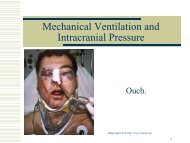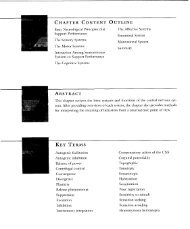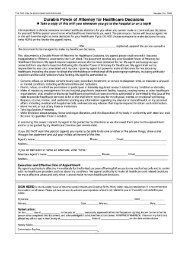Guidelines for the Diagnosis and Management of Asthma
Guidelines for the Diagnosis and Management of Asthma
Guidelines for the Diagnosis and Management of Asthma
You also want an ePaper? Increase the reach of your titles
YUMPU automatically turns print PDFs into web optimized ePapers that Google loves.
<strong>Diagnosis</strong> <strong>of</strong> <strong>Asthma</strong><br />
To establish a diagnosis <strong>of</strong> asthma, <strong>the</strong> clinician<br />
should determine that symptoms <strong>of</strong> recurrent<br />
episodes <strong>of</strong> airflow obstruction or airway<br />
hyperresponsiveness are present; airflow<br />
obstruction is at least partially reversible; <strong>and</strong><br />
alternative diagnoses are excluded.<br />
KEY SYMPTOM INDICATORS FOR CONSIDERING<br />
A DIAGNOSIS OF ASTHMA<br />
The presence <strong>of</strong> multiple key indicators increases <strong>the</strong><br />
probability <strong>of</strong> asthma, but spirometry is needed to establish<br />
a diagnosis.<br />
■ Wheezing—high-pitched whistling sounds when<br />
breathing out—especially in children. A lack <strong>of</strong> wheezing<br />
<strong>and</strong> a normal chest examination do not exclude asthma.<br />
■ History <strong>of</strong> any <strong>of</strong> <strong>the</strong> following:<br />
— Cough (worse particularly at night)<br />
— Recurrent wheeze<br />
— Recurrent difficulty in breathing<br />
— Recurrent chest tightness<br />
■ Symptoms occur or worsen in <strong>the</strong> presence <strong>of</strong>:<br />
— Exercise<br />
— Viral infection<br />
— Inhalant allergens (e.g., animals with fur or hair,<br />
house-dust mites, mold, pollen)<br />
— Irritants (tobacco or wood smoke, airborne chemicals)<br />
— Changes in wea<strong>the</strong>r<br />
— Strong emotional expression (laughing or crying hard)<br />
— Stress<br />
— Menstrual cycles<br />
■ Symptoms occur or worsen at night, awakening <strong>the</strong> patient.<br />
■ Episodic symptoms <strong>of</strong> airflow obstruction or<br />
airway hyperresponsiveness are present.<br />
■ Airflow obstruction is at least partially reversible,<br />
measured by spirometry. Reversibility is determined<br />
by an increase in FEV 1 <strong>of</strong> >200 mL <strong>and</strong> ≥12<br />
percent from baseline measure after inhalation <strong>of</strong><br />
short-acting beta 2 -agonist (SABA). Some studies<br />
indicate that an increase <strong>of</strong> ≥10 percent <strong>of</strong> <strong>the</strong><br />
predicted FEV 1 after inhalation <strong>of</strong> a SABA may<br />
have higher likelihood <strong>of</strong> separating patients<br />
who have asthma from those who have chronic<br />
obstructive pulmonary disease (COPD).<br />
■ Alternative diagnoses are excluded. See discussion<br />
below.<br />
Recommended methods to establish <strong>the</strong> diagnosis<br />
are:<br />
■ Detailed medical history. See figure 3, “Suggested<br />
Items <strong>for</strong> Medical History,” <strong>for</strong> questions to<br />
include.<br />
■ Physical examination may reveal findings that<br />
increase <strong>the</strong> probability <strong>of</strong> asthma, but <strong>the</strong><br />
absence <strong>of</strong> <strong>the</strong>se findings does not rule out<br />
asthma, because <strong>the</strong> disease is variable <strong>and</strong> signs<br />
may be absent between episodes. The examination<br />
focuses on:<br />
— upper respiratory tract (increased nasal<br />
secretion, mucosal swelling, <strong>and</strong>/or nasal polyp;<br />
— chest (sounds <strong>of</strong> wheezing during normal<br />
breathing or prolonged phase <strong>of</strong> <strong>for</strong>ced<br />
exhalation, hyperexpansion <strong>of</strong> <strong>the</strong> thorax, use<br />
<strong>of</strong> accessory muscles, appearance <strong>of</strong> hunched<br />
shoulders, chest de<strong>for</strong>mity); <strong>and</strong><br />
— skin (atopic dermatitis, eczema).<br />
■ Spirometry can demonstrate obstruction <strong>and</strong> assess<br />
reversibility in patients ≥5 years <strong>of</strong> age. Patients’<br />
perceptions <strong>of</strong> airflow obstruction are highly<br />
variable. Spirometry is an essential objective<br />
measure to establish <strong>the</strong> diagnosis <strong>of</strong> asthma,<br />
<strong>Diagnosis</strong> <strong>of</strong> <strong>Asthma</strong><br />
11





